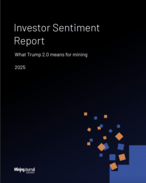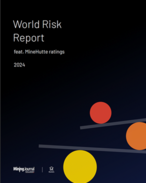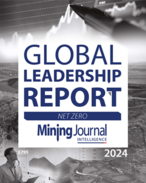Outages, shortages and falling mineral treatment charges have emerged as metal price drivers just as stimulus spending revives the Chinese economy, a combination which points to a buoyant 2025 for the mining industry.
Dulling this rosy glow of optimism is the uncertainty associated with the US Presidential election, wars in Ukraine and the Middle East, and a traditional Christmas and New Year slowdown.
But it's in the obscure world of treatment charges and refining charges (TC/RCs) that the most interesting news for miners can be found because they have plunged, a usually reliable indication of a supply shortage.
BHP cut
Layered on top of the collapse in TC/RCs are a series of mine outages with the latest being at BHP which has been forced to cut production at its Olympic Dam copper and uranium mine in Australia after lightning strikes knocked out power supplies.
BHP's outage is not a major event in the copper market, but it comes after the closure of the Cobre Panama mine, reduced supply from the Los Broncos and El Soldado mines, while Chile's champion Codelco is running at a 25-year low.
Bauxite has also become a raw material in short supply thanks to a dispute in Guinea which has trimmed shipments from the world's major supplier of the ore for the alumina industry, which is putting pressure on the aluminium market.
Two reports three-days apart from ANZ, an Australian bank, covered the way significant supply and demand factors are working their way into metal prices, followed by a confident report from Deutsche Bank on iron ore as Chinese demand picks up and the price rises back to a forecast US$130 a tonne.
The first ANZ report on metal supply was published last Friday under the headline "Ore-stricken" which noted how tightness was emerging in base metal markets as cases of unplanned disruptions started to increase.
"Many copper miners have downgraded production estimates this year," ANZ said.
"Supple disruptions are also rising in the bauxite market and is already effecting alumina output.
"Price led closures that resulted in a 1.5% drop in 2023 mined zinc supply appear to be continuing in 2024."
Earlier today, ANZ followed up with the demand side of its analysis under the headline "China restocking the shelves".
China restocking?
Seen by some observers as a strategic move by China as it readies for an escalation in its trade war with the U.S. and a possible attempt to invade Taiwan there is another reason for China restocking the shelves; confidence that stimulus spending will boost the country's economy.
Whatever the reason for Chinese buying it is having an effect in the metals market where prices have been edging higher. Aluminium, for example, is up 22% since this time last year while alumina, which has been hit by the bauxite shortage, is up 42% at an all-time high of $680/t.
But it's in the costs of treating and refining that that a more interesting trend is seen and while not widely reported ANZ has published some remarkable numbers that highlight a crash in TC/RCs.
"Fees that smelters charge for processing concentrates have dropped sharply in recent months," ANZ said – though just how much is the big surprise.
"Those fees were set at $80 per tonne of ore and 8c per pound of contained metal during last year's annual supply/contract negotiations.
"However, spot trades are currently at around $5/t and .05c/lb (half a cent), respectively" – falls of 93.7%.
TC/RCs are an inverse guide to commodity demand. When raw material, such as ores and concentrate are readily available, smelters and refiners can charge more for their services. When there is a shortage, they are forced to cut prices to get what they need to keep treating and refining.
"In the lead and zinc concentrate market, the squeeze is clear to see in the Chinese spot market," ANZ said.
"Treatment charges for imported concentrates have sunk to a multi-year low of $10/t. This is a long way down from the annual benchmark smelter terms of $165/t agreed at the start of the year to now be at unprofitable levels for many operators."
Iron ore, which briefly fell below $90/t last month is back above $100/t and could keep rising to $130/t if Deutsche Bank is right in predicting a recovery in the Chinese property market as government stimulus flows into the economy.
ANZ can see the Chinese led commodity sector recovery flowing across the mining industry with imports of copper and iron ore leading the way because of a shortage of local material in China, meaning import levels are "likely to remain elevated and relatively inelastic to prices".
China's stimulus spending when combined with increasing examples of mine outages and supply shortages, and the sudden collapse of TC/RCs are encouraging guides to a strong year ahead for miners.






















MINER'S RIGHT
Falling TC/RCs point to tight metal markets and rising prices
Strong year for miners
Miner's Right | Credits: Aspermont
Outages, shortages and falling mineral treatment charges have emerged as metal price drivers just as stimulus spending revives the Chinese economy, a combination which points to a buoyant 2025 for the mining industry.
Dulling this rosy glow of optimism is the uncertainty associated with the US Presidential election, wars in Ukraine and the Middle East, and a traditional Christmas and New Year slowdown.
But it's in the obscure world of treatment charges and refining charges (TC/RCs) that the most interesting news for miners can be found because they have plunged, a usually reliable indication of a supply shortage.
BHP cut
YOU MIGHT ALSO LIKE
Layered on top of the collapse in TC/RCs are a series of mine outages with the latest being at BHP which has been forced to cut production at its Olympic Dam copper and uranium mine in Australia after lightning strikes knocked out power supplies.
BHP's outage is not a major event in the copper market, but it comes after the closure of the Cobre Panama mine, reduced supply from the Los Broncos and El Soldado mines, while Chile's champion Codelco is running at a 25-year low.
Bauxite has also become a raw material in short supply thanks to a dispute in Guinea which has trimmed shipments from the world's major supplier of the ore for the alumina industry, which is putting pressure on the aluminium market.
Two reports three-days apart from ANZ, an Australian bank, covered the way significant supply and demand factors are working their way into metal prices, followed by a confident report from Deutsche Bank on iron ore as Chinese demand picks up and the price rises back to a forecast US$130 a tonne.
The first ANZ report on metal supply was published last Friday under the headline "Ore-stricken" which noted how tightness was emerging in base metal markets as cases of unplanned disruptions started to increase.
"Many copper miners have downgraded production estimates this year," ANZ said.
"Supple disruptions are also rising in the bauxite market and is already effecting alumina output.
"Price led closures that resulted in a 1.5% drop in 2023 mined zinc supply appear to be continuing in 2024."
Earlier today, ANZ followed up with the demand side of its analysis under the headline "China restocking the shelves".
China restocking?
Seen by some observers as a strategic move by China as it readies for an escalation in its trade war with the U.S. and a possible attempt to invade Taiwan there is another reason for China restocking the shelves; confidence that stimulus spending will boost the country's economy.
Whatever the reason for Chinese buying it is having an effect in the metals market where prices have been edging higher. Aluminium, for example, is up 22% since this time last year while alumina, which has been hit by the bauxite shortage, is up 42% at an all-time high of $680/t.
But it's in the costs of treating and refining that that a more interesting trend is seen and while not widely reported ANZ has published some remarkable numbers that highlight a crash in TC/RCs.
"Fees that smelters charge for processing concentrates have dropped sharply in recent months," ANZ said – though just how much is the big surprise.
"Those fees were set at $80 per tonne of ore and 8c per pound of contained metal during last year's annual supply/contract negotiations.
"However, spot trades are currently at around $5/t and .05c/lb (half a cent), respectively" – falls of 93.7%.
TC/RCs are an inverse guide to commodity demand. When raw material, such as ores and concentrate are readily available, smelters and refiners can charge more for their services. When there is a shortage, they are forced to cut prices to get what they need to keep treating and refining.
"In the lead and zinc concentrate market, the squeeze is clear to see in the Chinese spot market," ANZ said.
"Treatment charges for imported concentrates have sunk to a multi-year low of $10/t. This is a long way down from the annual benchmark smelter terms of $165/t agreed at the start of the year to now be at unprofitable levels for many operators."
Iron ore, which briefly fell below $90/t last month is back above $100/t and could keep rising to $130/t if Deutsche Bank is right in predicting a recovery in the Chinese property market as government stimulus flows into the economy.
ANZ can see the Chinese led commodity sector recovery flowing across the mining industry with imports of copper and iron ore leading the way because of a shortage of local material in China, meaning import levels are "likely to remain elevated and relatively inelastic to prices".
China's stimulus spending when combined with increasing examples of mine outages and supply shortages, and the sudden collapse of TC/RCs are encouraging guides to a strong year ahead for miners.
RELATED ARTICLES
THEMES:
TOPICS:
< PREVIOUS ARTICLE
Lessons in chemistry, the Rio way
NEXT ARTICLE >
Mineral Resources crisis deepens
Get the Mining Journal Newsletter delivered free each day
FROM OUR PARTNERS
PARTNER CONTENT
Macquarie Arc: Elephants hiding in plain sight
PARTNER CONTENT
BHP builds 'beautiful' Xplor community